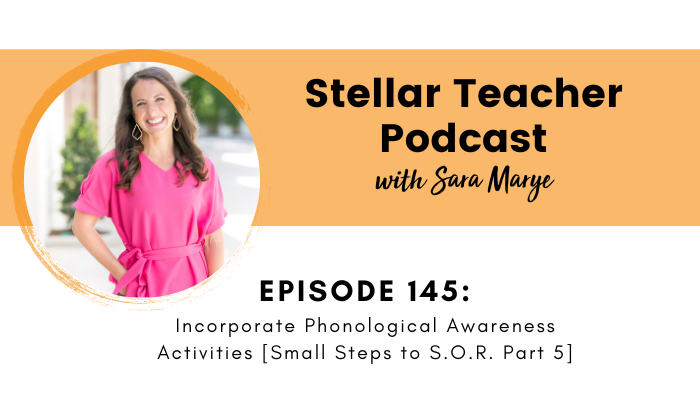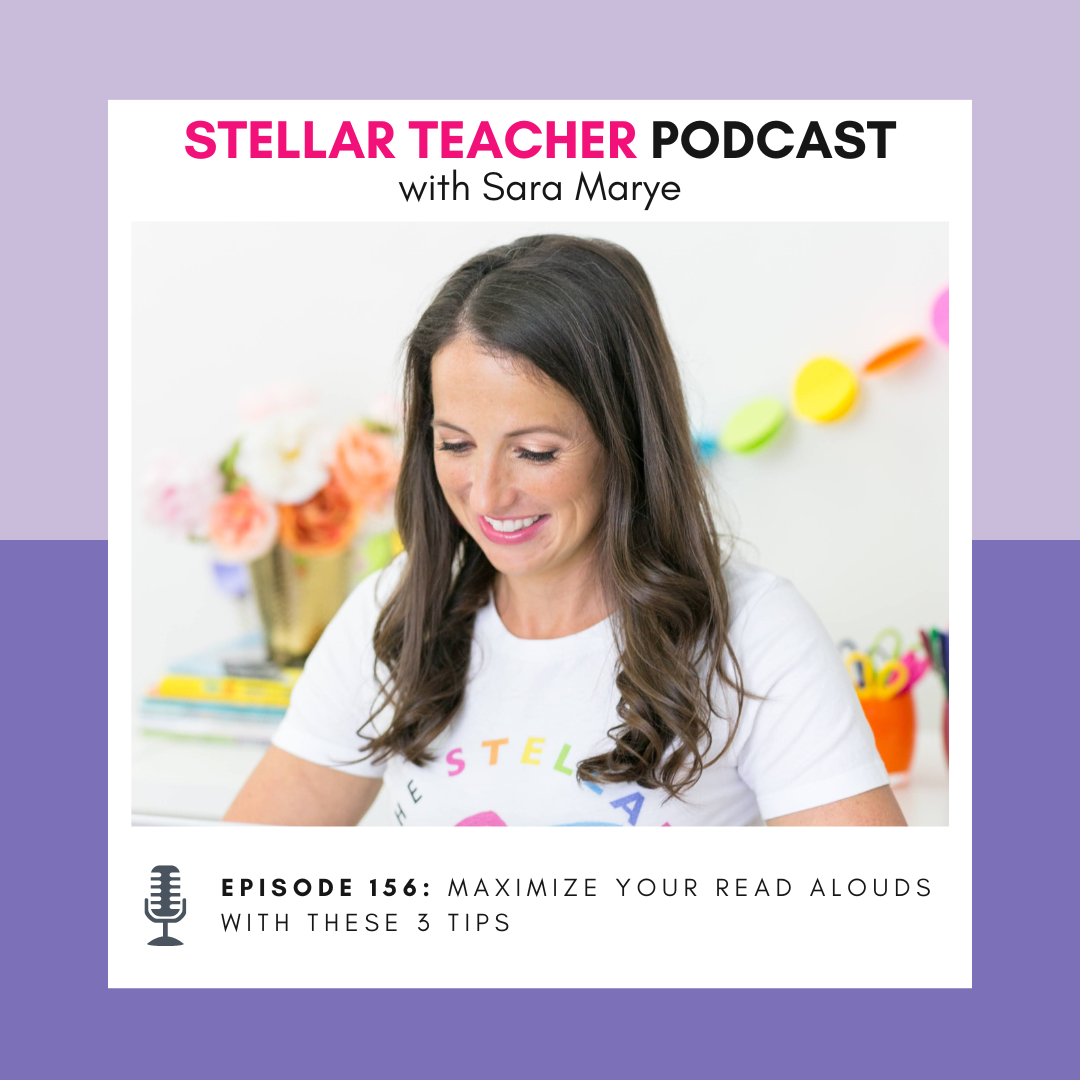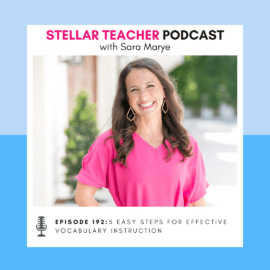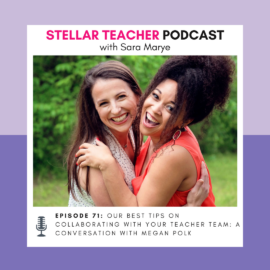
Click play below to hear phonological awareness activities:
We’ve talked before about how as upper elementary teachers, we sometimes think the foundational aspects of the science of reading aren’t as pertinent to us. However, by now you have learned that explicitly teaching word recognition and language comprehension skills helps your struggling readers.
That’s why incorporating phonological awareness activities into your instruction is a small step toward the science of reading.
Phonological awareness is the understanding of sounds in our language, which directly impacts a students’ level of comprehension and fluency. If any student has foundational gaps in phonics, making sure you implement phonological awareness activities will benefit those students, if not all.
I share 4 activities you can do with your students that are quick, low prep, and require no manipulatives. So take another step toward aligning your classroom with the science of reading by incorporating phonological awareness activities!
In this episode on phonological awareness activities, I share:
- Ways phonological awareness aligns with the science of reading
- A brief explanation of phonological awareness and the elements in relation to it
- How breaking down the word can help students understand multisyllabic words
- 4 short and effective activities to use with your students
Resources:
- Sign up for my Private Podcast: Confident Writer Systems Series
- Check out the Stellar Literacy Collective Membership
- If you’re enjoying this podcast, please leave a review on Apple Podcasts!
Related episodes and blog posts:
- Episode 143, Use a Semantic Map [Small Steps to S.O.R. Part 4]
- Episode 141, Explicitly Teach the Most Common Prefixes & Suffixes [Small Steps to S.O.R. Part 3]
- Episode 139, Practice Sentence Deconstruction [Small Steps to S.O.R. Part 2]
- Episode 137, Build and Activate Background Knowledge [Small Steps to S.O.R. Part 1]
- Episode 86, Understanding Phonological and Phonemic Awareness with Michelle and the Colorful Classroom
- Episode 85, What is the Science of Reading & Why is it Important?
Connect with me:
- Join my newsletter
- Shop my TPT store here
- Instagram: @thestellarteachercompany
More About Stellar Teacher Podcast:
Welcome to the Stellar Teacher Podcast! We believe teaching literacy is a skill. It takes a lot of time, practice, and effort to be good at it. This podcast will show you how to level up your literacy instruction and make a massive impact with your students, all while having a little fun!
Your host, Sara Marye, is a literacy specialist passionate about helping elementary teachers around the world pass on their love of reading to their students. She has over a decade of experience working as a classroom teacher and school administrator. Sara has made it her mission to create high quality no-fluff resources and lesson ideas that are both meaningful and engaging for young readers.
Each week, Sara and her guests will share their knowledge, tips, and tricks so that you can feel confident in your ability to transform your students into life-long readers.
Tune in on your favorite podcast platform: Apple, Google, Amazon, Spotify, Stitcher, and more! If you’re loving this podcast, please rate, review, and follow!
Podcast (stellar-teacher-podcast): Play in new window | Download
Hey there. Happy Thursday. This is the fifth episode in our summer series, small steps to SOR aka the science of reading. Each week, I have been airing a bonus episode on Thursdays where I am sharing a small step that upper elementary teachers just like you can take to align their instruction with the science of reading.
And my goal with this summer series is really to help you develop a much deeper understanding of what the science of reading is, because there’s a lot that goes into it. And I also want you to feel more confident in your ability to implement it in your classroom this next school year.
I know so many schools are making a shift and sending their teachers to professional development and switching curriculum, which I think is great if you’re finding something that’s going to work better for your students. But at the end of the day, teachers need to have a strong understanding of you know, how the science of reading works and the impact that it has on their students in order for any of those programs to be successful. And I hope that this podcast can be a part of your journey, and learning about the science of reading.
So let’s jump into today’s small step. One small step that you can take in your upper elementary classroom is to incorporate phonological awareness activities. And I’m going to explain exactly what phonological awareness activities is in a minute, because I have a suspicion that a few of you might be wondering what exactly that is.
But first, let’s talk about how this specific step aligns to the science of reading. And if you’ve been listening to every episode in my series, then each week you hear me talk about Scarborough’s reading rope, which is really just a great visual model for the skills that we need in order to become independently skilled readers.
And envision a rope. A rope is created by having two strands that are twisted together. And in our reading rope, one strand is word recognition. And that strand has sub elements that include phonological awareness, decoding, and sight word recognition. And then there’s a language comprehension strand, which includes background knowledge, vocabulary, syntax, literacy knowledge, and verbal reasoning.
And proficient readers are not missing any of the individual strands we see in Scarborough’s reading rope. This means that teaching each of the strands to our students is not really optional for us as teachers, if we want the end result to be skilled reading. And even an upper elementary, we need to be intentional about teaching each of the individual elements both with word recognition and with language comprehension.
And when students struggle with reading, we really need to be intentional about giving them support in all aspects of the word recognition strand specifically, because, you know, in upper elementary, there’s been a sort of a long history that we tend to focus on comprehension, and we assume that learning how to decode and understanding, you know, sounds and all of that stuff happens in lower elementary.
But when students struggle, we need to make sure that we’re supporting them in word recognition, and phonological awareness is a huge part of that. So let’s talk about what exactly phonological awareness is.
Phonological awareness is the awareness of sounds in the oral language, and it’s the ability to manipulate those sounds. And in addition, phonological awareness includes noticing similarities and patterns between units of sounds. So it’s really this big understanding of sounds in our language.
And phonological awareness is an umbrella term that includes five different skills that you’ve probably are familiar with, and those include sentence segmenting, syllable segmenting, rhyming, alliteration, and phonemic awareness. And phonemic awareness is a term that you’ve probably heard before. But even within phonemic awareness, there is a set of sub skills that include blending individual sounds, isolating phonemes and a phoneme is the smallest unit of sound. So you’ll hear that a lot when we talk about phonemic awareness phonemic sound.
So other parts of phonemic awareness include segmenting phonemes, adding phonemes, deleting phonemes, substituting phonemes so it has everything to do with just this ability to really hear individual sounds and then manipulate them within words. And research has shown that phonological awareness is a strong predictor of success with reading and spelling.
Yet at the same time, it is something that we often think is only for lower elementary classrooms. And it’s you usually not a category of reading that upper elementary teachers get much training or support on. And it’s not really something that we naturally incorporate into our classrooms.
But many struggling readers and third, fourth and fifth grade have deficits in at least one of the areas of phonological awareness that I just mentioned. And when that happens when we have students that have deficits in these areas, they’re going to have difficulties with spelling and with reading.
And even if students do get explicit instruction on phonics principles, which is the sound spelling correspondence, so even if they have strong phonics understanding, they still might struggle, because they don’t have a strong enough awareness of sounds. So having this understanding and awareness of sounds is so important for our students if we want them to develop a strong reading foundation.
So even if we think of phonemic awareness as something that is usually taught in lower elementary, it’s actually really important to incorporate into our upper elementary classrooms, because it is going to help your struggling readers fill in the gaps.
The good news is, is that there is a variety of specific phonological and phonemic awareness activities that you can do with your students to help strengthen this really important foundational skill. And I’m going to share a few things that you can do with your students to help strengthen their phonological awareness.
And the first thing you can do is focus on blending and segmenting. And blending and segmenting are two of the most basic phonemic awareness activities that you can help your students develop. And blending occurs when you break a word down into its individual phonemes, which are the individual sounds, and then you ask students to tell you what the word is.
So you give students the sounds, they give you the word. An example would be, you give students the sound N O Z, and they’re going to give you the word nose. Mou would say M A SH they would blend it together and be able to say mash. You would say P OO D LE they would put that together and say poodle.
So this is a really important skill for students to have. But segmenting is also really important. And segmenting is the opposite. Segmenting happens when you give students the word. And then they break it down into their individual sounds. You would give students the word ship, and you would want them to say SH I P. You would give them the word date dnd they would say D A T. You would give them the word napkin, and they would say N A P K N.
And both segmenting and blending are great to help students build sound fluency, which leads to automatic word recognition. And it also helps with spelling. And you’ll notice with both of these examples, they go quick, these aren’t activities that take a super long time, you don’t even necessarily need to, you know, do a ton of planning or prep work.
Most phonological and phonemic awareness activities can be done orally, with no writing, no, you know, manipulatives nothing else you can do all of this just, you know, with your students right before a warm up for a read aloud before a small group. They’re just really quick activities that you can do with your students.
So another activity that you can do is to help your students hear syllables in a word. And there’s a lot of different syllable type phonological awareness activities you can do, and I’m going to share two of them with you.
Okay, the first is syllable blending. And this is really similar to blending in general, but rather than giving students individual sounds, you’re going to say a word very slowly and separate it by syllables. And so students are going to just be blending syllables rather than blending sounds.
To introduce an activity like this, you could say something like Syllable Sam speaks very slowly, what word is Syllable Sam trying to say? And then you would say P nut. And then we want students to put that together to say peanut, you would say car pet, we want students to put that together to say carpet, you would say Valentine, that put it together, say Valentine.
And this type of activity can be really good when you get into multisyllabic words. So something like comm pre hend students put it together to say comprehend, fan tas tic. Students who put it together to say fantastic. com bi na tion students put together to say combination.
This can help students understand that especially as we get into longer multisyllabic words, that these big long words are still broken down into smaller parts that they can recognize. So syllable blending is one thing that you can do.
The second is when you delete a syllable, and you can tell students that you’re going to play a game and you’re going to break long words into parts and delete one of the part. So if I say candlestick without stick, I’m left with candle. It If I say caption without tion, I’m left with cap. And then we want our students to, you know, follow the example what’s basketball without ball basket, what’s refocus without re focus, what’s timetable without time table, what’s entertainment without meant entertain.
And this can be really good, especially when you’re introducing things like prefixes and suffixes because we can help students understand that those are individual syllables, their word parts that we can eliminate them. And we can still be left with words that are sort of like standalone on their own. So those are two syllable activities that you can do.
And a syllable is a single unit of pronunciation. And we really want our students to be able to automatically hear individual syllables and sounds. And like I mentioned earlier, especially as students in upper elementary become more and more exposed to multisyllabic words, it’s really important that they are able to distinguish syllable boundaries and words.
And working on phonological awareness activities like these, in combination with focusing on explicit syllable instruction can really help students build up confidence and mastery in this area. And I think that is an important thing to remember that phonological awareness activities on their own aren’t going to be enough and phonics instruction on its own isn’t going to be enough, it’s really that combination of the two, that really lead up to mastery.
Okay, the third activity that you can do is sound substitution. And sound substitution is when we give students an opportunity to manipulate and change the sounds in a word. And you can do initial sound substitutions, medial sound substitutions, and final sound substitutions.
And this would look something like you know, start by telling your students, you want to see if they can make some new words by changing just one sound in the word. And really, in general, anytime you’re doing phonological awareness activities, you would want to model to your students first, you could say something like, listen to me, if I change the m in Moon to s I get the word soon.
Then you’re going to have your students practice by doing the same thing. And so then you would prompt them by saying, change the b in beat to m. And you would get meat. Change the s in sing to th and you get thing. Change the R in writing to h you get hiding.
And so those are some examples of initial sound substitutions. And you can also do medial sound substitutions. This is where students are changing the middle sound. And so it would be, you know, change the i in zip to a nd you would get zap, change the aw in fawn to a and you get fan, change the a and chap to aw, and you get chop.
And those are a little bit more challenging, because it’s not the first sound that students hear. And so this is definitely more difficult for students. But we also want them to understand that, you know, this is going to force them to really focus to all of the individual sounds in a word and understand that, you know, the slight vowel difference makes a difference in the pronunciation of the word.
And then you can also do final sound substitutions. And again, it’s the same sort of example you want to model to your students first, and then give them the prompt. So we would ask our students, you know, what happens when we change the t in hat to m and students would have to be able to give us the word ham. What happens when we change the k in fork to t, we would get fort.
You can even do it with more advanced multisyllabic words like change the ing in teaching to er, you get teacher. And substitutions are great because students really have to think about where the sound is located and the word whether it is the beginning, middle, and end, and what happens when that sound is changed. And it really just contributes to that really strong sound awareness, which is the goal that we are working towards with phonological awareness activities.
So these are just a few examples of phonological and phonemic awareness activities. But there are so many more that you can do with your students. And what’s really great is that most phonological awareness activities are short, so they take very little time to incorporate into your classroom. And I know teachers always feel like they are crunched for time that they never have enough time. But these can easily be things that you can tack on to other parts of your literacy block.
You can do you know a few phonological awareness activities right before a read aloud or at the start of a small group lesson. Or even if you’re getting ready to transition to another class and have a few extra minutes you can throw in some of these phonological awareness activities.
And when you focus on phonological awareness, you are going to be supporting your students who really struggled with reading and spelling and it is an important part of the reading rope that we need to focus on even in upper elementary.
So that is my small step to SOR for this week. And that is incorporate phonological awareness activities in your upper elementary classroom. And I shared a few in this episode that hopefully you’ll be able to try out this next year with your students.
And I have two more small steps that I will be sharing as part of our small steps to SOR series, so be sure that you continue to tune in next Thursday to hear my next small step that you can take to align your instruction with the science of reading, and until then have a stellar week.








Leave a Comment
You must be logged in to post a comment.